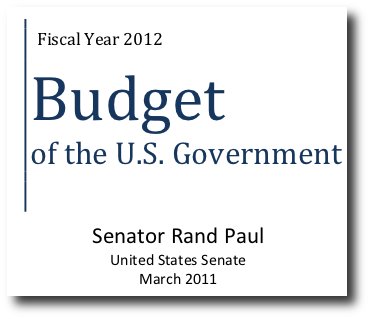Rand Paul's 2012 budget proposal was, for the most part, received by his colleagues in Congress with a deafening silence. With good reason. But it provides a wealth of insights into Rand Paul's thought processes that shouldn't just be swept under the rug.
In today's installment we look at his proposal for spending by the legislative branch, or, of Congress itself.
Paul's proposal is simple enough. Reduce spending to 2008 levels and get rid of the Government Printing Office.
Spending by the Legislative Branch
Sen. Paul begins his argument by correctly stating that the budget for Congress and its support agencies has increased by "more than 100 percent" since 2000. This in and of itself, to Paul, is a problem. He doesn't investigate what Congress and its support agencies are doing with the money. He doesn't discuss what it is used for. It has doubled in 10 years and, to him, that is the problem.
By failing to investigate beyond the surface level spending, Paul fails to see some really important facts. For instance, as the graph below shows, the legislative branch's budget as a percent of total government spending has not doubled in the last 10 years. In fact, the legislative budget consumed a smaller percentage of overall government spending in 2008, 2009 and 2010 than any year of the Bush presidency and this trend is forecast to continue through 2016!
Not only is the legislative branch spending less of the federal budget than any time in the last ten years, it is consuming no greater portion of GDP than it typically has. In fact, the overall trend has been that the legislative branch spends less of GDP than it used to. During the 1980's the legislative branch spent about .04 percent of GDP. Since 2000 it has spent between .025 percent and .028 percent. The most recent "spike" actually occurs because of shrinking or stagnating GDP more so than out of control spending to conduct the nation's legislative business. See below.
In Rand Paul's discussion of legislative spending, he skips from his fallacious point about the legislative budget to top marginal tax rates over time, the percent of GDP accounted for by the entire federal government, and the meaningless when taken out of context statistic of how many years in the last decade have had deficits over a trillion dollars. While all interesting discussions, they have nothing whatsoever to do with whether the money spent on legislating is being well spent. Nothing.
Government Printing Office
According to Paul, "Advancements in technology have led to the electronic age, an era that eliminates the need for the government to print exorbitant numbers of documents, many of which can be accessed and read on the Internet." Paul would like to see each government office budget for their own printing costs. He is particularly annoyed that the GPO spent $30 million providing Congressional offices with "the rarely read Congressional Record". Mind you, the 2010 winner of President Obama's SAVE award, won for her idea of eliminating the paper version of the Federal Register. Can the paper version of the Congressional Record be far behind?
Senator Paul's preference for ideology over intellectual curiosity gets the better of him here. First, the budget of the GPO is less than a billion dollars. Most of that budget, however, is funded by the agencies that use its services. The actual general fund appropriation for the GPO is less than $200 million.
Anyone with corporate IT or printing experience knows that there are enormous economies of scale available in these areas. Centralization of processes, purchasing, standards, etc. not only creates huge fiscal savings, it is absolutely imperative if end users are ever to be able to find and read anything! Pushing the GPO's operations out to every agency of government would massively increase overall costs.
Further, while the GPO prints an enormous quantity of paper at the request of all those agencies, it has a leading role in the making sure that government documents are available electronically. Yes, you read that right. The GPO is in charge of the technology that Rand Paul says makes the agency obsolete.
Does the government print a lot of paper it doesn't have to? Undoubtedly it does. Good governance would go about figuring out what paper doesn't need to be printed so it can be stopped. Infantile governance goes about eliminating the agency that keeps printing and printing costs under control.






